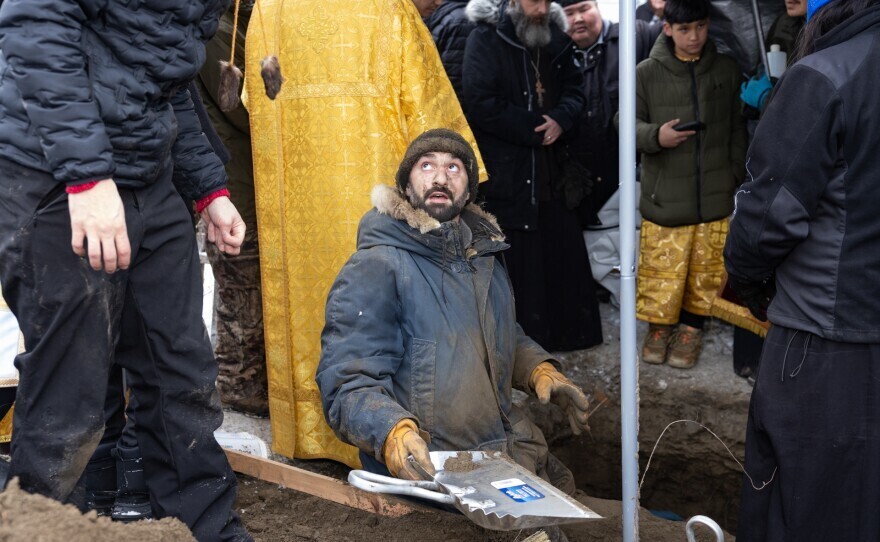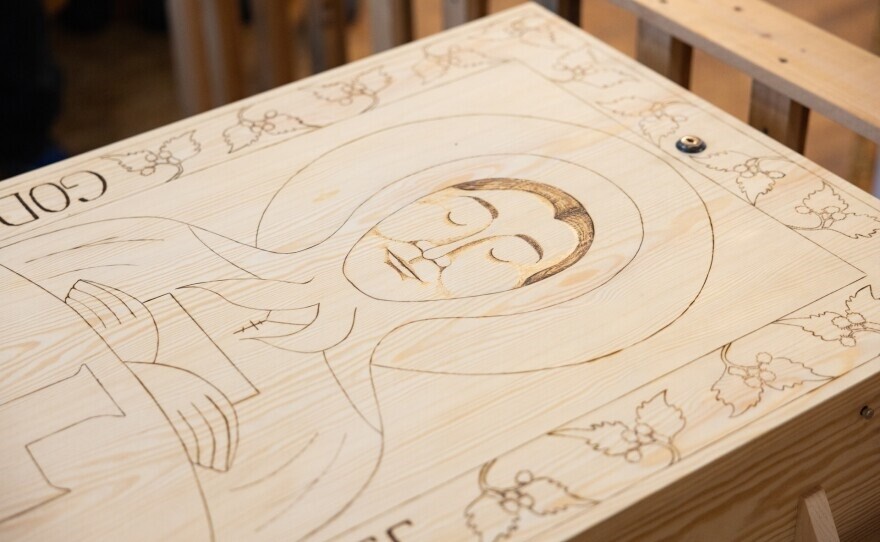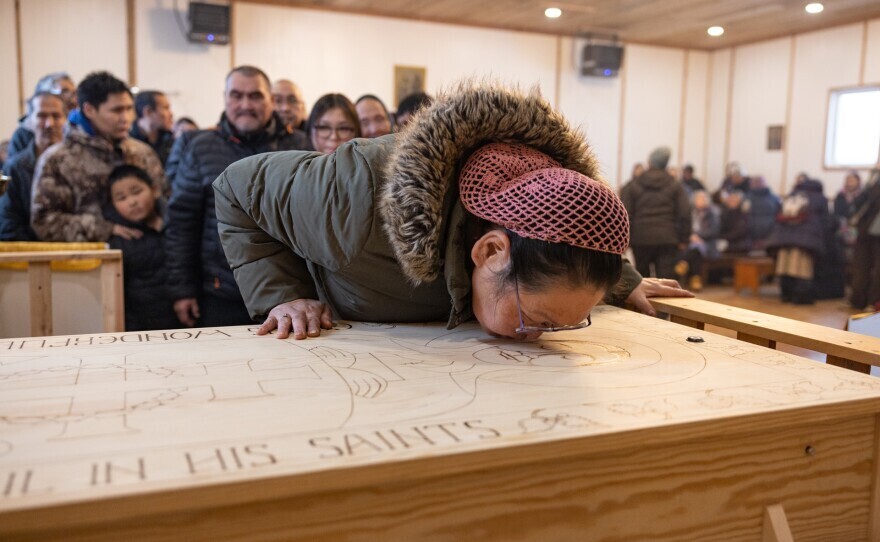Puffs of feathery snow drifted among the crowd gathered at the cemetery of the St. Nicholas Orthodox Church in Kwethluk on a bitter cold Saturday in mid-November. Clergy, Kwethluk residents and people from as far away as Eastern Europe stood packed between the tight rows of graves, while dogs weaved through the crowd. The people sang a final blessing to St. Olga of Alaska before the task at hand began.
“We're going to begin now the process of uncovering the relic of a saint,” said Bishop Alexei, the head of the Russian Orthodox Diocese of Sitka and Alaska, wearing a heavy fur-lined robe and holding a golden crozier topped with two serpents.
Bishop Alexei traveled to Kwethluk alongside clergy from across the state. With the blessing of Orthodox faithful from the region, the church is completing the next step in making Olinka “Arrsamquq” Michael, or Matushka Olga, the first female Orthodox saint in North America, and the first-ever Yup’ik saint.
“All of us, I think, must ask in our heart that holy Matushka Olga will help us, will bless us to do this thing which is not done anywhere,” Alexei said.
Half a dozen priests huddled under a tarped enclosure and drove steel bars into the frozen tundra where St. Olga was laid to rest 45 years ago. The ground quickly began to crack and peel away to reveal soft, sandy soil that the mid-November frost hadn’t yet touched.
For the entire, hours-long exhumation process, clergy took turns continuously chanting from the Gospels, the biblical account of the life and teachings of Jesus. Others kept a constant supply of incense and charcoal burning, which wafted through the crowd and over the growing hole.
St. Olga’s granddaughter, Margaret Michael, stood placidly as the pile of dirt grew next to the grave. She said it’s an honor to see her grandmother made a saint, and to hear faraway accounts of her healing powers after her death. But Michael said, for her, St. Olga simply represents the strength and compassion of Yup’ik culture.
“For the most part, Yup’ik people are like how she was. So I thought of her, like, as a normal human being until those people started dreaming about her,” Michael said.
At the graveside, dirt from the grave was carefully packed into Ziploc bags, which were distributed through the crowd and tucked into backpacks and coats. The holy soil will be used as a tool for healing among the people that fill the cemetery and their congregations back home.
It’s been more than 50 years since a saint’s remains were exhumed in Alaska, but soil from St. Herman’s resting place on Spruce Island near Kodiak is still used in the same healing way today.
At one end of the growing pile, Zoya Ayapan gathered up soil. She said she became sick as a newborn in Kwethluk, and that when she suddenly got well her parents named her after Matushka Olga.
“One of my names is Arrsamquq. I was born like a month before she passed away,” Ayapan said.
Ayapan said that the recognition of St. Olga is a blessing for Kwethluk.
“The stories that I've heard of Matushka Olga, she goes to anybody, and I think the healing is for everybody that needs healing,” Ayapan said. “I was talking to Fr. Vasily (Fisher) before all this, and I said, ‘I think Kwethluk is going to be on the map for a good thing this time, you know.’”
Up from the grave
After more than four hours of digging down into the tundra, the splintered wood cover overlaying St. Olga’s metal casket came up from the grave.
The priests fastened ropes to the corners of the casket, just as they were fastened on Nov. 8, 1979, when Matushka Olga was lowered into the ground.
The ropes stretched tight and held fast to the casket as it rose from the grave. Laypeople, priests, and pilgrims who persevered through the bitter cold suddenly began to sing a prayer for mercy in the ancient Church Slavonic language used throughout the Orthodox world.
There was some anxiety in the air. Despite detailed plans for the first exhumation by the church in Alaska in more than 50 years, it wasn’t clear what the condition of the grave would be, or whether the casket might fall to pieces under its own weight.
But under the bishop’s direction, a dozen priests found a way to carry the casket through the decaying headstones and along the snowy lane leading the short distance to the new church as the crowd followed behind, transfixed.
The priests worked as a team to make a final push up the stairs. As St. Olga’s relics disappeared inside, the church bell triumphantly rang out to announce her arrival.
The crowd was too large to fit inside the St. Nicholas Orthodox Church, and it spilled down the stairs and onto the boardwalk below. Inside, the bishop and priests transferred St. Olga’s relics to a new wood coffin crafted by monastic nuns from California.
When the nave of the church finally opened – more than five hours after the ceremony began – there was no speech or grand exaltation. The mood was solemn. Tears flowed across some of the faces in the crowd.
The new resting place was adorned with an icon of St. Olga, surrounded by salmonberries. Matushka Olga’s relatives were first in line to kneel and kiss the coffin. The blessings they received from their family member turned saint will soon be shared with pilgrims from across the world.
In June 2025, Bishop Alexei and leaders throughout the Orthodox Church in America will be back in Kwethluk for the final step in making her sainthood official, a process known as glorification.
“This is to allow the larger church to also show their love for blessed Matushka Olga. But the primary service is really for the Yup’ik people who have been so extremely gracious, so very giving,” Alexei said. “Our entire time here, they have literally given everything they have, precisely the way Matushka Olga had taught them.”
The glorification will be unprecedented. But the same can be said for everything that has happened over the past year to the woman and wife of a priest from Kwethluk known as a mother, a midwife, a healer, and now a saint.
Matushka Olga’s relics will remain on display in the nave of the Kwethluk church as the community prepares for the final step in her canonization.










